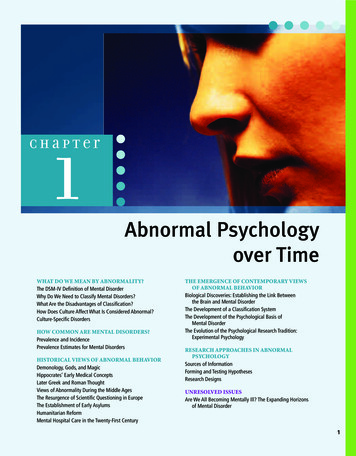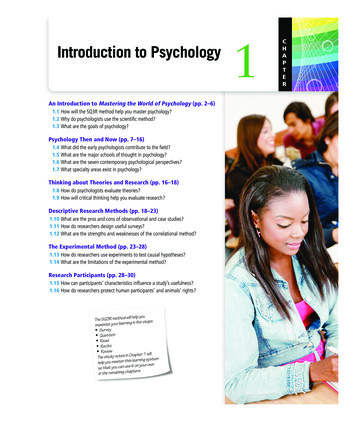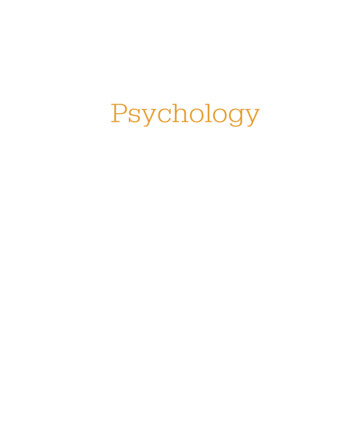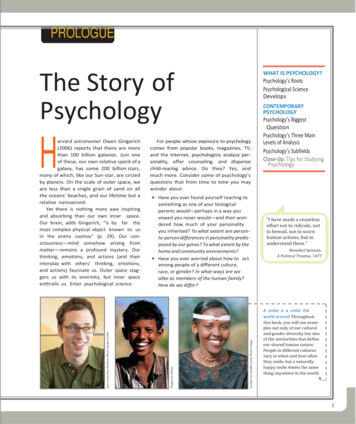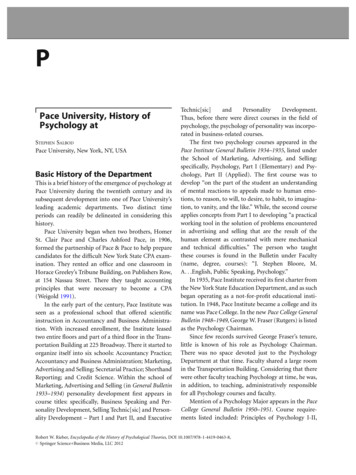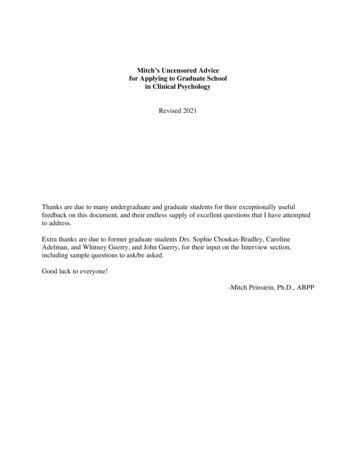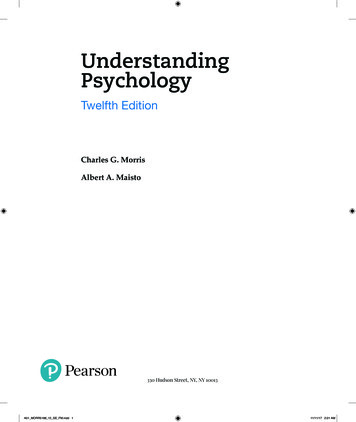
Transcription
UnderstandingPsychologyTwelfth EditionCharles G. MorrisAlbert A. Maisto330 Hudson Street, NY, NY 10013A01 MORR5188 12 SE FM.indd 111/11/17 2:01 AM
Executive Portfolio Manager: Erin MitchellSenior Development Editor: Rebecca GreenPortfolio Manager Assistant: Louis FierroContent Producer Manager: Amber MackeyContent Producer: Lisa MafriciDirector of Field Marketing: Jonathan CottrellExecutive Product Marketing Manager: Chris BrownSenior Field Marketing Manager: Debi DoyleAssociate Director of Design: Blair BrownDesign Lead: Kathryn FootCover Design: PentagramDigital Producer: Lindsay VergeFull-Service Project Management/Composition: Margaret McConnell/IntegraCover and Text Printer/Binder: WillardCopyright 2019, 2016, 2013 by Pearson Education, Inc. or its affiliates. All Rights Reserved. Printed in the United Statesof America. This publication is protected by copyright, and permission should be obtained from the publisher prior to anyprohibited reproduction, storage in a retrieval system, or transmission in any form or by any means, electronic, mechanical,photocopying, recording, or otherwise. For information regarding permissions, request forms and the appropriate contactswithin the Pearson Education Global Rights & Permissions department, please visit www.pearsoned.com/permissions/.Library of Congress Cataloging-in-Publication DataNames: Morris, Charles G., author. Maisto, Albert A. (Albert Anthony)author.Title: Understanding psychology / Charles G. Morris, Albert A. Maisto.Description: Twelfth Edition. Hoboken : Pearson Education, Inc., [2018] Revised edition of the authors’ Understanding psychology, [2016] Includes bibliographical references and index.Identifiers: LCCN 2017047121 ISBN 9780134625188Subjects: LCSH: Psychology.Classification: LCC BF121 .M5987 2018 DDC 150—dc23LC record available at https://lccn.loc.gov/2017047121117Student Edition:ISBN-10: 0-13-462518-8ISBN-13: 978-0-13-462518-8A01 MORR5188 12 SE FM.indd 211/11/17 2:01 AM
Brief Contents1The Science of Psychology 110Personality 3512The Biological Basis of Behavior 3711Stress and Health Psychology 3803Sensation and Perception 7712Psychological Disorders 4124States of Consciousness 11913Therapies 4495Learning 15314Social Psychology 6Memory 1877Cognition and Mental Abilities 221Appendix A: Measurement andStatistical Methods 5188Motivation and Emotion 269Appendix B: Psychology Appliedto Work 5299Life-Span Development 304484iiiA01 MORR5188 12 SE FM.indd 311/11/17 2:01 AM
A01 MORR5188 12 SE FM.indd 411/11/17 2:01 AM
ContentsPreface ixFrom the Publisher xv1The Science of Psychology What Is Psychology? The Breadth of Psychology Enduring Issues Psychology as Science Critical Thinking: Thinking Like a Scientist The Growth of Psychology as a Science The “New Psychology”: A Science of the Mind Redefining Psychology: The Study of Behavior The Cognitive Revolution New Directions Where Are the Women? 133789111214151617Human Diversity 19Gender 19Race and Ethnicity 20Culture 21Research Methods in Psychology 22Naturalistic Observation 23Case Studies 23Surveys 23Correlational Research 24Experimental Research 25A Replication Crisis? 26Multimethod Research 27The Importance of Sampling 28Ethics and Psychology: Research on Humans and Animals 30Animal Research 32Chapter Review 33 Test Yourself 352The Biological Basis of Behavior Behavior Genetics Social Implications Evolutionary Psychology Chapter Review 73 Test Yourself369707175Sensation and Perception 77Enduring Issues in Sensation and Perception 79The Nature of Sensation Sensory Thresholds Subliminal Perception 798081Vision 83The Visual System 83Color Vision 87Hearing 91Sound 91The Ear 93Theories of Hearing 95The Other Senses 97Smell 97Taste 99Kinesthetic and Vestibular Senses 100The Skin Senses 100Pain 101Perception 103Perceptual Organization 105Perceptual Constancies 106Perception of Distance and Depth 108Perception of Movement 111Visual Illusions 112Observer Characteristics 113Chapter Review 115 Test Yourself 117374States of Consciousness 119Enduring Issues in the Biological Basis of Behavior 39Enduring Issues in States of Consciousness Neurons: The Messengers The Neural Impulse The Synapse Neural Plasticity and Neurogenesis 39414346The Central Nervous System The Organization of the Nervous System The Brain Hemispheric Specialization Tools for Studying the Brain The Spinal Cord 494949545760Sleep 121Circadian Cycles: The Biological Clock 122The Rhythms of Sleep 123Sleep Deprivation 124Sleep Disorders 126The Peripheral Nervous System 61The Endocrine System 64Genes, Evolution, and Behavior 66Genetics 67121Dreams 128Why Do We Dream? 129Drug-Altered Consciousness Substance Use, Abuse, and Dependence Depressants: Alcohol, Barbiturates, and the Opiates Stimulants: Caffeine, Nicotine, Amphetamines,and Cocaine Hallucinogens and Marijuana Explaining Abuse and Addiction 132133134139142144vA01 MORR5188 12 SE FM.indd 511/11/17 2:01 AM
vi ContentsMeditation and Hypnosis 146Meditation 146Hypnosis 147Chapter Review 149 Test Yourself 1515Learning 153Enduring Issues in Learning 155Classical Conditioning Establishing a Classically Conditioned Response Classical Conditioning in Humans Classical Conditioning Is Selective 155156157158Special Topics in Memory Cultural Influences Autobiographical Memory Extraordinary Memory Flashbulb Memories Eyewitness Testimony Recovered Memories 210210211212213214215Chapter Review 217 Test Yourself 2197Cognition and Mental Abilities Enduring Issues in Cognition and Mental Abilities 221222Operant Conditioning 159Elements of Operant Conditioning 160Establishing an Operantly Conditioned Response 161A Closer Look at Reinforcement 162Punishment 164Learned Helplessness 165Shaping Behavioral Change Through Biofeedback 166Building Blocks of Thought 223Language 223Images 226Concepts 226Non-Human Language and Thought The Question of Language Animal Cognition 228228228Factors Shared by Classical and Operant Conditioning The Importance of Contingencies Extinction and Spontaneous Recovery Stimulus Control, Generalization, and Discrimination New Learning Based on Original Learning Summing Up Cognitive Learning Latent Learning and Cognitive Maps Insight and Learning Sets Learning by Observing Cognitive Learning in Nonhumans Problem Solving Interpreting Problems Implementing Strategies and Evaluating Progress Obstacles to Solving Problems er Review 182 Test Yourself 1856Memory 187Enduring Issues in Memory 189The Sensory Registers 189Visual and Auditory Registers 189Attention 190Short-Term Memory Capacity of STM Encoding in STM Maintaining STM 192192194194Long-Term Memory Capacity of LTM Encoding in LTM Serial Position Effect Maintaining LTM Types of LTM Explicit and Implicit Memory 195195195195196199199The Biology of Memory Where Are Memories Stored? The Role of Sleep 202203205Forgetting 206The Biology of Forgetting 206Experience and Forgetting 207A01 MORR5188 12 SE FM.indd 6Decision Making 236Framing 236Compensatory Decision Making 237Decision-Making Heuristics 238Explaining Our Decisions 239Intelligence and Mental Abilities Theories of Intelligence Intelligence Tests What Makes a Good Test? 241243245247Heredity, Environment, and Intelligence 250Heredity 250Environment 251The IQ Debate: A Useful Model 253Mental Abilities and Human Diversity: Genderand Culture 254Extremes of Intelligence 256Creativity 259Intelligence and Creativity 259Creativity Tests 260Answers to Problems in the Chapter Answers to Intelligence Test Questions 261263Chapter Review 264 Test Yourself 2678Motivation and Emotion Enduring Issues in Motivation and Emotion 269271Perspectives on Motivation 271Instincts 271Drive-Reduction Theory 271Arousal Theory 272Intrinsic and Extrinsic Motivation 273A Hierarchy of Motives 27411/11/17 2:01 AM
ContentsHunger and Thirst Biological and Emotional Factors Eating Disorders and Obesity 275276277Sex 282Biological Factors 282Cultural and Environmental Factors 283Patterns of Sexual Behavior Among Americans 284Sexual Orientation 285Other Important Motives 287Exploration and Curiosity 287Manipulation and Contact 287Aggression 288Achievement 290Affiliation 290Emotions 291Basic Emotions 292Theories of Emotion 293Communicating Emotion 295Voice Quality and Facial Expression 295How the Brain Reads the Face 296Body Language, Personal Space, and Gestures 296Gender and Emotion 298Culture and Emotion 299Chapter Review 301 Test Yourself 3029Life-Span Development 304Enduring Issues in Life-Span Development 306Methods in Developmental Psychology 306Prenatal Development 308The Newborn 309Reflexes 310Temperament 310Perceptual Abilities 311Infancy and Childhood Neurological Development Physical and Motor Development Cognitive Development Moral Development Language Development Social Development Sex-Role Development 312313314315318319321325Adolescence 327Physical Changes 327Cognitive Changes 329Personality and Social Development 330Some Problems of Adolescence 331Adulthood 333Personality Traits 333Love, Partnerships, and Parenting 334The World of Work 337Cognitive Changes 338Midlife 338A01 MORR5188 12 SE FM.indd 7Late Adulthood Physical Changes Social Development Cognitive Changes Facing the End of Life vii340342343344344Chapter Review 346 Test Yourself 34910Personality 351Enduring Issues in Personality 353Studying Personality 353Psychodynamic Theories Sigmund Freud Carl Jung Alfred Adler Karen Horney Erik Erikson A Psychodynamic View of Jaylene Smith Evaluating Psychodynamic Theories 354354356357358358359360Humanistic Personality Theories Carl Rogers A Humanistic View of Jaylene Smith Evaluating Humanistic Theories 361361362362Trait Theories The Big Five A Trait View of Jaylene Smith Evaluating Trait Theories 363364366367Cognitive–Social Learning Theories Expectancies, Self-Efficacy, and Locus of Control A Cognitive–Social Learning View of Jaylene Smith Evaluating Cognitive–Social Learning Theories Personality Assessment The Personal Interview Direct Observation Objective Tests Projective Tests 368369370370372372372372374Chapter Review 376 Test Yourself 37811Stress and Health Psychology Enduring Issues in Stress and Health Psychology 380381Sources of Stress 381Change 383Everyday Hassles 383Self-Imposed Stress 385Stress and Individual Differences 386Coping with Stress Direct Coping Defensive Coping Socioeconomic, Cultural, and Gender Differencesin Coping with Stress 388388390How Stress Affects Health Stress and Heart Disease Stress and the Immune System 39339539639111/11/17 2:01 AM
viii ContentsStaying Healthy Reduce Stress Adopt a Healthy Lifestyle 397397400Extreme Stress Sources of Extreme Stress Posttraumatic Stress Disorder The Well-Adjusted Person 402402404406Chapter Review 408 Test Yourself 41012Psychological Disorders 412Enduring Issues in Psychological Disorders 414Perspectives on Psychological Disorders How Does a Mental Health Professional Define aPsychological Disorder? Historical Views of Psychological Disorders The Biological Model The Psychoanalytic Model The Cognitive–Behavioral Model The Diathesis–Stress Model and Systems Theory The Prevalence of Psychological Disorders Mental Illness and the Law Classifying Abnormal Behavior The Effects of Stigma on a Diagnosis of Mental Illness 414414416417417417418418419420421Psychological Disorders 422Mood Disorders 422Anxiety Disorders 427Somatic Symptom and Related Disorders 429Sexual Dysfunctions 431Paraphilic Disorders 433Gender Dysphoria 434Personality Disorders 435Schizophrenia Spectrum and Other Psychotic Disorders 436Neurodevelopmental Disorders 439Gender and Cultural Differences in PsychologicalDisorders 442Chapter Review 444 Test Yourself 44613Therapies 449Enduring Issues in Therapies 451Insight Therapies 451Psychoanalysis 451Client-Centered Therapy 453Recent Developments 454Group Therapies Family Therapy Couples Therapy Self-Help Groups 461462462462Effectiveness of Psychotherapy Which Type of Therapy Is Best for Which Disorder? 464466Biological Treatments 468Drug Therapies 468Electroconvulsive Therapy 471Neurosurgery 472Institutionalization and Its Alternatives 474Deinstitutionalization 474Alternative Forms of Treatment 475Prevention 475Client Diversity and Treatment 476Gender and Treatment 477Culture and Treatment 478Chapter Review 480 Test Yourself 48214Social Psychology 484Enduring Issues in Social Psychology 486Social Cognition 486Forming Impressions 486Attribution 488Interpersonal Attraction 490Attitudes 493The Nature of Attitudes 493Prejudice and Discrimination 494Changing Attitudes 497Social Influence 502Cultural Influences 502Conformity 503Compliance 504Obedience 505Social Action 508Deindividuation 508Helping Behavior 508Groups and Decision Making 510Leadership 512Chapter Review514 Test Yourself516Appendix A: Measurement and Statistical Methods 518Appendix B: Psychology Applied to Work 529540Behavior Therapies Therapies Based on Classical Conditioning Therapies Based on Operant Conditioning Therapies Based on Modeling 456457458458Answer Key Cognitive Therapies Stress-Inoculation Therapy Rational–Emotive Therapy Beck’s Cognitive–Behavioral Therapy 459459460460Credits CR-1A01 MORR5188 12 SE FM.indd 8Glossary G-1References R-1Name Index NI-1Subject Index SI-111/11/17 2:01 AM
PrefaceContinued Focus on Basic UnifyingConceptsIn this new edition, we continue to focus on three unifying, basicconcepts, which have been woven throughout every edition ofour texts:1. Psychology is a science that is rapidly evolving. From thethousands of articles that have appeared during the pastseveral years, we selected more than 300 new referencesfor this edition, almost all of which are from 2013–2016.Examples of new material include common myths aboutpsychology, the “replication crisis,” the influence of coloron psychological functioning, neuroimaging of dreaming,effects of marijuana, binge drinking, increased heroin use,mindful meditation, role of images and concepts in thinking, Kahneman and Tversky’s System 1 and System 2,multitasking and cellphone use while driving, “brain training,” eating disorders, sexual orientation, attachment theory, early- and late-maturers, youth violence, personalitychange in young adulthood, the changing role of marriage,Holland’s approach to career choice, cognitive-social learning theories, preparing for the impact of climate change, resilience, group walks in nature, the effects of mental healthstigma, diagnosis of gender dysphoria, specific phobias,positive and negative symptoms of schizophrenia, basis ofsystematic desensitization, and combating “fake news.”2. Human behavior and thought are diverse, varied, andaffected by culture. We have continued to give close attention to diversity. Woven throughout the chapters we emphasize the importance of understanding the role culture,gender, and human diversity play in shaping virtually everyaspect of human behavior including: cognition, learning,memory, emotion, motivation, stress, mental illness, sexuality, development, perception, and drug effects.3. The study of psychology involves active thinking, questioning, and problem solving. We retained all of the“Thinking Critically” exercises and now encourage studentsto actively weigh in through Journal Prompts tied to thesefeatures in Revel. The topics encourage the reader to engagein genuine critical thinking by questioning the methods usedto gather data, considering possible alternative explanationsfor findings, and imagining further research that might shedadditional light on the phenomenon under study.Continuing Attention to EnduringIssuesWe believe that an important part of active learning is for students to recognize recurring themes that run through the material they are reading. In Chapter 1, we introduce a set offive Enduring Issues that cut across and unite all subfields ofpsychology (see pages 7–8): Person–Situation: To what extent is behavior caused by processes that occur inside the person, such as thoughts, emotions, and genes? In contrast, to what extent is behavior causedor triggered by factors outside the person, such as i ncentives,cues in the environment, and the presence of other people? Nature–Nurture: Is the person we become a product of innate,inborn tendencies, or a reflection of experience and upbringing? Stability–Change: Are the characteristics we developin childhood more or less permanent and fixed, or do wechange in predictable (and unpredictable) ways over thecourse of our lives? Diversity–Universality: Because we are all human, eachperson is like every other person. But in some respects,each person is only like certain other people. And in other respects, each of us is like no other person. Thus, anywherehumans exist there will be both similarity and diversity. Mind–Body: How are mind and body connected? Manypsychologists are fascinated by the relationship betweenwhat we experience, such as thoughts and feelings, and biological processes, such as activity in the nervous system.These five issues represent enduring themes in the history ofpsychology. Depending on the events and intellectual climate ofa given time period, one or another of these issues has assumedspecial prominence. For example, the role of genetics (heredity)is receiving much greater attention today than it has in the past.Diversity is also an issue of much greater concern, as is the roleof biological processes.Throughout this book, we will highlight the importance ofthese matters. Each chapter opens with a section highlighting theenduring issues to be encountered in that chapter. Several timesin each chapter we will call the reader’s attention to the way inwhich the topic under consideration—whether it be new discoveries about communication within the nervous system, researchinto how we learn, or the reason that people abuse drugs—reflectsone of these issues. In this way, we will show the surprising unityand coherence of the diverse and exciting science of psychology.LEARNING OBJECTIVESThe chapter learning objectives were carefully written to coverthe content of each chapter and to ensure that students whomaster the objectives will indeed have a thorough grasp of thematerial. The objectives also help to organize the supplementarymaterial, allowing for easy customization by instructors.OPENING VIGNETTESEach chapter of our text begins with an opening vignette.Reviewers have often commented on how useful it is to have theixA01 MORR5188 12 SE FM.indd 911/11/17 2:01 AM
x Prefacevignette woven throughout the chapter to help students understand and apply information.New to This EditionWith each new edition, we strive to make the text as current as possible. This is always a challenge because psychology is changingso rapidly. We have cited more than 300 new references in this edition in an effort to capture the most important new developments.We have also updated numerous figures with the most recent dataavailable.We also strive to improve the book based on suggestionsfrom the professors and students who use the current edition.We were especially fortunate to have extremely thoughtful andhelpful comments and suggestions from a dozen reviewers. Wehave taken their input to heart in every chapter with what webelieve are significant improvements.We have added a number of features that we hope will engage students more fully in what they are learning. There aredozens of new surveys, Journal Prompts, videos, and animationsas can be seen in the list of new content below. The expandedRevel edition provides even more interactive features designedto increase student involvement.At the same time, our original goals for this book remain thesame. We wanted to present a scientific, accurate, and thoroughoverview of the essential concepts of psychology; to use engaging language that students can easily comprehend; to be currentwithout being trendy; and to write clearly and accessibly aboutpsychology and its concrete, real-life applications—wi thoutbeing condescending to the introductory-level student.CHAPTER 2 The Biological Basis of Behavior New video: Structure of the Neuron New video: Sensory and Motor Neurons New Journal Prompt: Thinking Critically About MirrorNeurons New video: The Neural Impulse Action Potential New video: The Synapse New video: Reuptake of Dopamine New Explore the Concept: The Divisions of the Brain New figure displaying the four lobes of the cerebrum New Explore the Concept: The Four Lobes of the Cerebrum New figure of the limbic system displaying additionalfeatures New glossary term: cingulate cortex New figure of sympathetic and parasympathetic nervoussystem New Journal Prompt: Thinking Critically About Tools forStudying the Brain New video: The Spinal Cord Reflex New Explore the Concept: Functions of the Parasympatheticand Sympathetic Divisions of the Nervous System New survey: Do You Fight or Fly? New figure of the endocrine system New Explore the Concept: The Glands of the EndocrineSystem New video: Chromosomes and DNACHAPTER 1 The Science of Psychology Chapter reorganized and new material added to increasestudent involvement/interest New chapter introduction New Journal Prompt: Thinking Critically About MediaAccounts of Research New end-of-chapter shared writing assignment New flashcards for key terms New survey: What Do You Know About Psychology? 5 revised end-of-module quizzes and a new end-of-chapterquiz New material on subfields of psychology 29 new references New Explore the Concept: Major Subfields of Psychology New section Critical Thinking: Thinking Like a Scientist New Social Explorer: Percentage of Women Recipients ofPhDs in Psychology 1950–2010 New Journal Prompt: Thinking Critically About Psychologyand Minority Students New survey: Participating in a Research Survey New video: Independent vs. Dependent Variables New section: A Replication Crisis? New material on the importance of sampling/diversity New Journal Prompt: Thinking Critically About Internet Users New end-of-chapter shared writing assignment New flashcards for key terms 5 revised end-of-module quizzes and a new end-of-chapterquiz 17 new referencesA01 MORR5188 12 SE FM.indd 10CHAPTER 3 Sensation and Perception New material at the start of the chapter that distinguishessensation from perception New survey: Which Senses Do You Use? New Journal Prompt: Thinking Critically About Advertisingand Subconscious Messages New video: Structure of the Eye New Explore the Concept: Interactive Eye Anatomy New material on the influence of color on psychologicalfunctioning New Explore the Concept: Color Vision in DifferentSpecies New Explore the Concept: Sound New Journal Prompt: Thinking Critically About an AncientQuestion11/11/17 2:01 AM
Preface New Journal Prompt: Thinking Critically About Pheromones New ExploreConditioning New video: The Tongue and Taste Buds New video: Negative Reinforcement New Explore the Concept: Binocular Cues to DepthPerception New Journal Prompt: Thinking Critically About CorporalPunishment New end-of-chapter shared writing assignment New Journal Prompt: Biofeedback and Neurofeedback New flashcards for key terms New video: Schedules of Reinforcement 5 revised end-of-module quizzes and a new end-of-chapterquiz New Explore the Concept: Examples of Reinforcement inEveryday Life 9 new references New Journal Prompt:Reinforcement Schedules New video: Cochlear callyAbout New Social Explorer: Response Acquisition and Extinctionin Classical ConditioningCHAPTER 4 States of Consciousness New survey: What Altered States Have You Experienced? New video: Sleep Stages New Social Explorer: Results of the Tolman and HonzikStudy New Social Explorer: Results of Bandura’s Study Updated terminology revising the stages of sleep New Journal Prompt: Thinking Critically About SleepDeprivation New video: Sleep Disorders New Journal Prompt: Thinking Critically About Sleep Lossand Illness New survey: Are Dreams Meaningful? New material on the neuroimaging of dreaming New Explore the Concept: Activation and Synthesis Theoryof Dreaming New survey: What Learning Techniques Do You Use? New end-of-chapter shared writing assignment New flashcards for key terms 4 revised end-of-module quizzes and a new end-of-chapterquiz 6 new referencesCHAPTER 6 Memory New video: Inattentional Blindness New material on increased potency of marijuana New video: Improving Your Memory Using Mnemonics New survey: What Drugs Have You Used? New Social Explorer: Teenage Use of Alcohol New Journal Prompt: Thinking Critically About Types ofMemory Revised and updated material on Binge Drinking New video: The Neuroscience of Memory New Social Explorer: Persons Killed in Alcohol-RelatedTraffic Crashes New Explore the Concept: The Biological Basis of Memory New material on increased heroin use in the United States New material on music as a retrieval cue New Social Explorer: Teenage Use of Ecstasy New Social Explorer: Teenage Use of Marijuana New Journal Prompt: Thinking Critically About EyewitnessTestimony New material on the effects of the early use of marijuana New survey: What Do You Remember? New Journal Prompt: Teenage Use of Marijuana New end-of-chapter shared writing assignment New material on the use of mindful meditation to relievechronic pain New flashcards for key terms New video: Reasons for Forgetting New material on the clinical applications of hypnosis 6 revised end-of-module quizzes and a new end-of-chapterquiz New end-of-chapter shared writing assignment 12 new references New flashcards for key terms 4 revised end-of-module quizzes and a new end-of-chapterquiz 29 new referencesCHAPTER 5 Learning New ExploreConditioningthe Extensively rewritten and reorganized to reduce length,increase student involvement and interest, and build stronger bridges between sections of the chapter New chapter introductionConcept:ElementsinClassical New video: Classical Conditioning: An Involuntary ResponseA01 MORR5188 12 SE FM.indd 11CHAPTER 7 Cognition and Mental Abilities New video: Cognitive Advantages of Multilingualism New material on the role of images and concepts inthinking11/11/17 2:01 AM
xii Preface Additional examples of problem solving to clarify concepts New Journal Prompt: Thinking Critically About SolvingProblems Clearer explanation of compensatory decision making New material on Kahneman and Tversky’s System 1 andSystem 2 (thinking fast and slow) New material on multitasking and cellphone use whiledriving Explore the Concept: Measuring Intelligence New Journal Prompt: Thinking Critically About MultipleIntelligences New Social Explorer: IQ Scores and Family Relationships New material on “brain training” New Journal Prompt: Thinking Critically About the FlynnEffect New Journal Prompt: Thinking Critically About InternationalComparisons of School Achievement New end-of-chapter shared writing assignment New flashcards for key terms 7 revised end-of-module quizzes and a new end-of-chapterquiz 27 new referencesCHAPTER 8 Motivation and Emotion New survey: What Motivates You? New Journal Prompt: Thinking Critically About PrimaryDrives New video: Maslow’s Hierarchy of Needs New Summary Table: Perspectives on Motivation New material on eating disorders New figure on rising obesity among American youth New video: The Human Sexual Response Cycle New material on sexual orientation New video: Sexual OrientationCHAPTER 9 Life-Span Development Extensively rewritten and reorganized to reduce length New Explore the Concept: Advantages and Disadvantagesof Different Types of Developmental Research Methods Additional examples of teratogens New video: Newborn Reflexes New Social Explorer: Synaptic Density in the Human Brainfrom Infancy to Adulthood New Explore the Concept: Piaget’s Stages of CognitiveDevelopment Expanded coverage of attachment theory New video: Attachment New Explore the Concept: Erickson’s Eight PsychosocialStages New video: Parenting Styles New survey: Gender and Sexuality New Journal Prompt: Thinking Critically About Television’sEffects New material on early- and late-maturers New Social Explorer: Sex Among High School Students New material on youth violence New Journal Prompt: Thinking Critically About KidsWho Kill New material on personality change in young adulthood New material on the ways in which the role of marriage ischanging New Social Explorer: Marital Satisfaction New material on Holland’s approach to career choice New data on dual-career families New Social Explorer: Psychological Well-Being Across theLife-Span New end-of-chapter shared writing assignment New flashcards for key terms New video: Nature/Nurture of Sexual Orientation 7 revised end-of-module quizzes and a new end-of-chapterquiz New video: Factors Influencing Aggression 48 new references New survey: How Do You Deal with Your Emotions? New material on how the brain reads the faceCHAPTER 10 Motivation and Emotion New Summary Table: Theories of Emotion New survey: What Has Shaped Your Personality? New Journal Prompt: Thinking Critically About NonverbalCommunication of Emotion New material on the Big Five Dimensions of Personality New video: Display Rules New end-of-chapter shared writing assignment New Journal Prompt: Thinking Critically About CulturalUniversals New flashcards for key terms New Explore the Concept: Theories of Personality 5 revised end-of-module quizzes and a new end-of-chapterquiz New video: The Rorschach Test 21 new references New flashcards for key termsA01 MORR5188 12 SE FM.indd 12 New material on cognitive-social learning theories New end-of-chapter shared writing assignment11/11/17 2:01 AM
Preface 5 revised end-of-module quizzes and a new end-of-chapterquiz 14 new referencesxiii New flashcards for key terms 3 revised end-of-module quizzes and a new en
Brief Contents 1 The Science of Psychology 1 2 The Biological Basis of Behavior 37 3 Sensation and Perception 77 4 States of Consciousness 119 5 Learning 153 6 Memory 187 7 Cognition and Mental Abilities 221 8 Motivation and Emotion 269 9 Life-Span Development 304 10 Personality 351 11 Stress and Health Psychology 380 12 Psychological Disorders 412 13 Therapies 449




